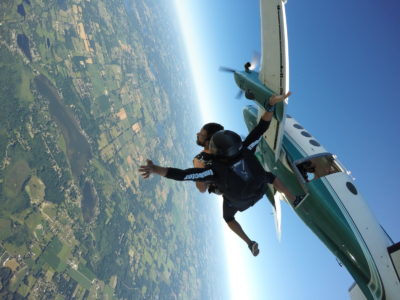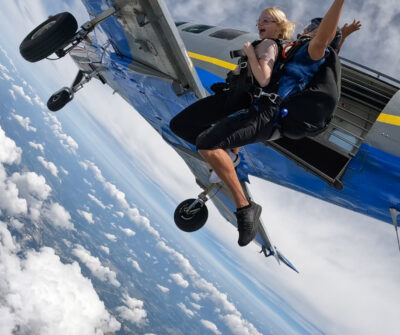- Michigan's Premier Skydiving Center
- Call Now: (517) 423-7720
The Skydiving Exit
Monday, August 28, 2023
- Skydive Tecumseh
- 8/28/23
- 0
- Blog, General
So you’ve booked your skydive and you’re running through the steps of your first jump … get there, gear up, load the airplane, exit, freefall, parachute ride, land … then you think: HOLD UP! How do we actually exit!? Do I just casually barrel-roll out of the airplane door? How big is the door? Does the skydiving exit order matter? Keep reading to answer these questions and more!
What Is A Skydiving Exit?
“Exit, exit, exit!” is something skydivers can shout once the door opens and it’s time to skedaddle out of the airplane. The skydiving exit is when a skydiver – solo or tandem – transitions from the open door of the airplane to the freefall portion of the skydive. There are many skydive exit techniques that all depend on many things, including who you’re jumping with, what you intend to do during freefall, and how high you’re exiting from.
Skydiving Exit Altitude
 How long do you stay in the air skydiving? Freefall time is dependent on how high the jumper is when they exit the aircraft. Exit altitude for solo jumpers is typically between 4,000 and 14,000 feet, while tandem pairs usually exit between 9,000 and 14,000 feet. The exit altitude depends on a couple of things, including the type of aircraft and what the plan for the skydive is. Some airplanes don’t have the ability to go above 10,000 feet and this prohibits jumpers from exiting from a higher altitude. Don’t worry, we have airplanes that go fast and high!
How long do you stay in the air skydiving? Freefall time is dependent on how high the jumper is when they exit the aircraft. Exit altitude for solo jumpers is typically between 4,000 and 14,000 feet, while tandem pairs usually exit between 9,000 and 14,000 feet. The exit altitude depends on a couple of things, including the type of aircraft and what the plan for the skydive is. Some airplanes don’t have the ability to go above 10,000 feet and this prohibits jumpers from exiting from a higher altitude. Don’t worry, we have airplanes that go fast and high!
What is a dive flow and how does it affect the type of exit used? A dive flow refers to the plan skydivers have for the freefall portion of the jump. If the dive flow includes a 5-way belly formation, the exit may have three people hanging on the outside of the door and the other two diving the door after them. The possibilities are endless!
What is a hop-n-pop? “Hops” are typically done from a lower altitude and are used to focus on canopy skills. This type of exit (hop) entails the skydiver only waiting a couple of seconds after exit to deploy (pop!) their main canopy, totally skipping the freefall.
Skydiving Exit Order
Skydivers may come across as the most “willy-nilly” group of people, but be assured that all of our decisions are very deliberate and calculated! Why does the order in which skydivers exit skydive aircraft matter? It’s all about separation. We really don’t want skydivers deploying their canopies too close to one another.
Here’s an example: skydiving Group A is going to do a belly jump, so they’re going to fall mostly straight down and stay in the same spot. Group B wants to do a movement jump (meaning, they will intentionally move horizontally across the sky). If Group A exits and then seven seconds later Group B exits, Group B won’t be able to see Group A and may track into A’s air space and could end up right above them. And, since Group A is a bit below Group B, they may not be able to see B, they’ll deploy their canopies first (since they are lower) and Group B could smash right into them. Yikes! What is the scariest part about skydiving? This potential scenario is up there!
Hop-n-pops from low altitudes always go first! After them, the first group to exit the aircraft are typically movement groups – these are the guys from Group B who are doing angle or tracking. Then belly groups (largest to smallest), then freefly groups (largest to smallest), AFF students and their instructors, tandem students, and then wingsuiters.
What Are The Exit Techniques For Skydiving?
There are two common different skydiving exit techniques: the poised exit versus the dive exit. A poised exit is when the jumper is standing, turns their hips and faces toward the front of the airplane, and basically steps backward or sideways off of the plane. They arch and can watch the plane above – this is the first exit solo students learn to master. The diving exit is when the skydiver crouches down and “dives the door” (exits) as if they’re jumping into a pool, but it’s actually into the great, blue sky.
Fun Skydiving Exits
Horny Gorilla
2+ jumpers intertwining one of each of their legs and hurling themselves as a big spinning ball through the sky – sick!
Backflips
Front flips, back flips, and gainers are common exits! They’re great tools to practice getting restabilized.
Sit Train
Think: 2+ people sitting on the floor in a row all facing the same direction. Their legs are in front of them, and they tightly squeeze their knees on the sides of the person in front of them … now put this in the sky!
Mr. Bill
This type of jump is a hop-n-pop done from full altitude (not getting out low!) and entails Jumper B tightly holding onto the chest strap on the rig of Jumper A. Jumper A immediately deploys their canopy and (if all goes as intended) Jumper B will then be hanging onto them while both under the single parachute! Both jumpers are able to talk, and when the time comes, Jumper B will let go of Jumper A, essentially going into freefall, and then will deploy their own parachute (after enough separation, of course)! Fits the bill for cool skydiving exits, right?
As long as safety is #1, there truly is no “right” or “wrong” way to exit – the whole point is to strategically transition from the plane to the sky. If you can do that, then you’ll ace your exit! Book your skydive today and let us push you out of an airplane – AKA, nail that exit! Blue skies!

It was great. Went from 18,000ft. It was on July 2, 2016. It was my 2ndtandemm flight. I will definitely come back. Recommend Skydive Tecumseh to everyone it was a great way to start your day. I'm 63 and coming back every year. Very professional and friendly staff. I absolutely LOVED it.
Paul Davies
Copyright © 2025, Skydive Tecumseh, All Rights Reserved.
DropZone Web Design & Marketing by Beyond Marketing, LLC
